Brief Research Descriptions

In SHINE, we bring together expertise in applied electromagnetics and integrated circuit and system design to create a cohesive, forward-looking research program. A deep understanding of electromagnetic behavior from fields and waves to antennas, on-chip structures, and packaging combined with advanced integrated circuit and system design enables robust and reliable RF/mm-wave ICs that perform well under real-world parasitics and variability. The group works across the full chain from theory and modeling, through circuit and system design, to hardware implementation and measurement to deliver high-performance, energy-efficient analog, mixed-signal, and RF/mm-wave circuits and systems for wireless and wireline communications, radar, sensing, and healthcare applications.
Here are some examples of our current projects:
-
In-band full duplex systems
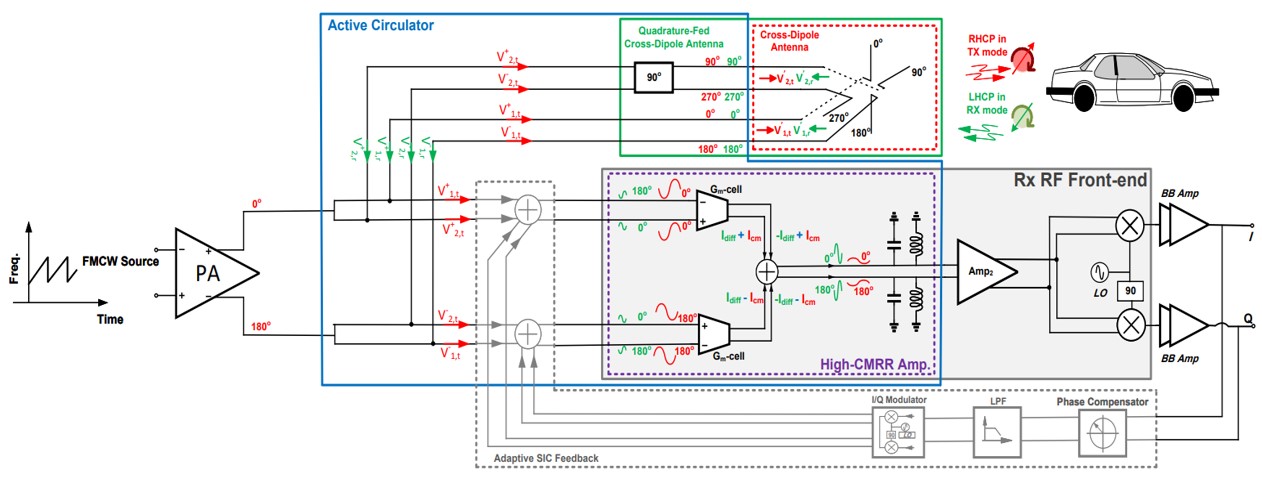
This research provides an innovative solution to a critical problem in simultaneous transmit and receive (STAR) communication and radar systems. In this research, our main focus is to address the significant issue of self-interference, a problem often leading to receiver nonlinearity and saturation. To address this challenge, we have designed a new active low-noise circulator in conjunction with a quadrature-fed antenna. This structure results in circular polarized radiation of the transmitting signal, segregating the echo and self-interference (SI) signals, and significantly attenuating the SI. As a proof of concept, the proposed SI cancellation configuration is designed for a 77-81 GHz FMCW radar system sharing a Tx/Rx antenna, and the radar’s performance verifies the superiority of the introduced technique.
-
Wearable Electronics

Wearable technology is becoming popular in medical fields, enabling early detection of various diseases such as sleep disorders. Sleep apnea, a significant sleep disorder, presents challenges due to expensive diagnostic methods. To address this, a compact wireless wearable device is developed to capture biosignals and transmit them to a smartphone. The device integrates an Inertial Measurement Unit (IMU) and a photoplethysmography (PPG) block to directly capture signals from the body. These signals are then modulated and wirelessly transmitted to the user’s smartphone via Bluetooth Low Energy (BLE). As the third block of the system, the smartphone's internal microphone records the user's breathing sounds throughout sleep. Together, the three blocks generate six signals: SpO₂, heart rate (both extracted from the PPG signal), breathing sound, and 3-axis acceleration, which are subsequently processed in MATLAB. By applying signal processing techniques, sleep apnea and hypopnea events, along with their timing, can be diagnosed with high accuracy. Based on an event-to-event comparison, the developed system achieves a sensitivity of 85.8% and an F1-score of 87.3% using a single signal. The use of a combined approach further enhances sensitivity, reliability, and the F1-score to 91%.
-
Ultra-low-power electronics
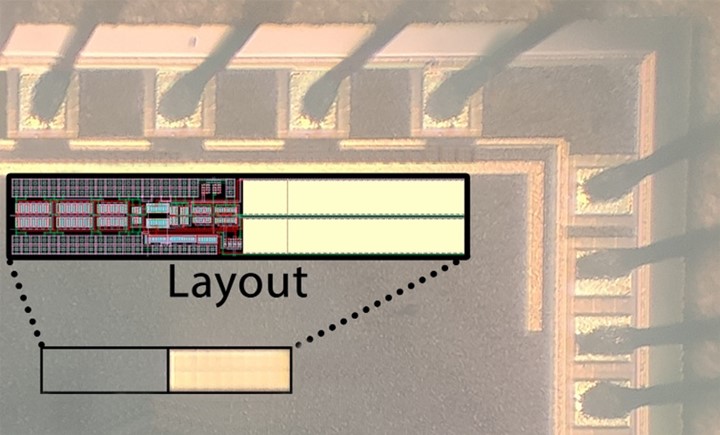
There is an increasing demand for ultra-low-power electronic systems to extend the battery life of portable devices, implantable biomedical instruments, and wearable health monitoring systems. Low-power and low-voltage systems also allow for the operation of wireless IoT devices through energy harvesting. This research presents two novel, low-noise, low-voltage, and energy-efficient amplifiers with high CMRR that can be used for portable or implantable biopotential acquisition systems such as implantable ECG and brain electrical activity monitoring microsystems.
-
low-power low-complexity high-speed wireline transceivers

To catch up with the escalating network traffic and to meet the ever-growing demand for high data rates in wireline communication systems while enhancing their power efficiency, we have offered several solutions in our group, a couple of which are outlined below:
-
We have introduced a novel signaling method (communication protocol) which is based on a Nyquist-rate orthogonal pulse amplitude modulation scheme. This innovative signaling approach allows for high-rate data transmission and high quality (with low sensitivity to noise and jitter) data reception while reducing the power consumption of wired transceivers. This efficiency is derived from the unique structure of the proposed signaling which eliminates the need for complex equalizers and clock and data recovery (CDR) circuits and allows for a simple implementation of the entire TRx using low-power integrated circuits.
-
Our group has also proposed a novel wireline communication system which incorporates a new oscillator allowing for precise control of both loop frequency and individual clock phases. This system is notable for its compact size and low power consumption.
-
-
High-resolution vector modulators for communications and radars

We have developed a low-power phase shifter with an independent control over both phase and amplitude of its output signal. This versatile phase shifter can be utilized to adjust clock pulse phases in wireline transceivers, as well as to independently control the phase and amplitude of excitation signals in phased array systems. With a 360-degree phase tuning range, compact size, minimal power consumption, and a simple control interface, this phase shifter is an excellent choice for 5G networks and low-power wireline communication systems.
-
novel beamforming/steering methods
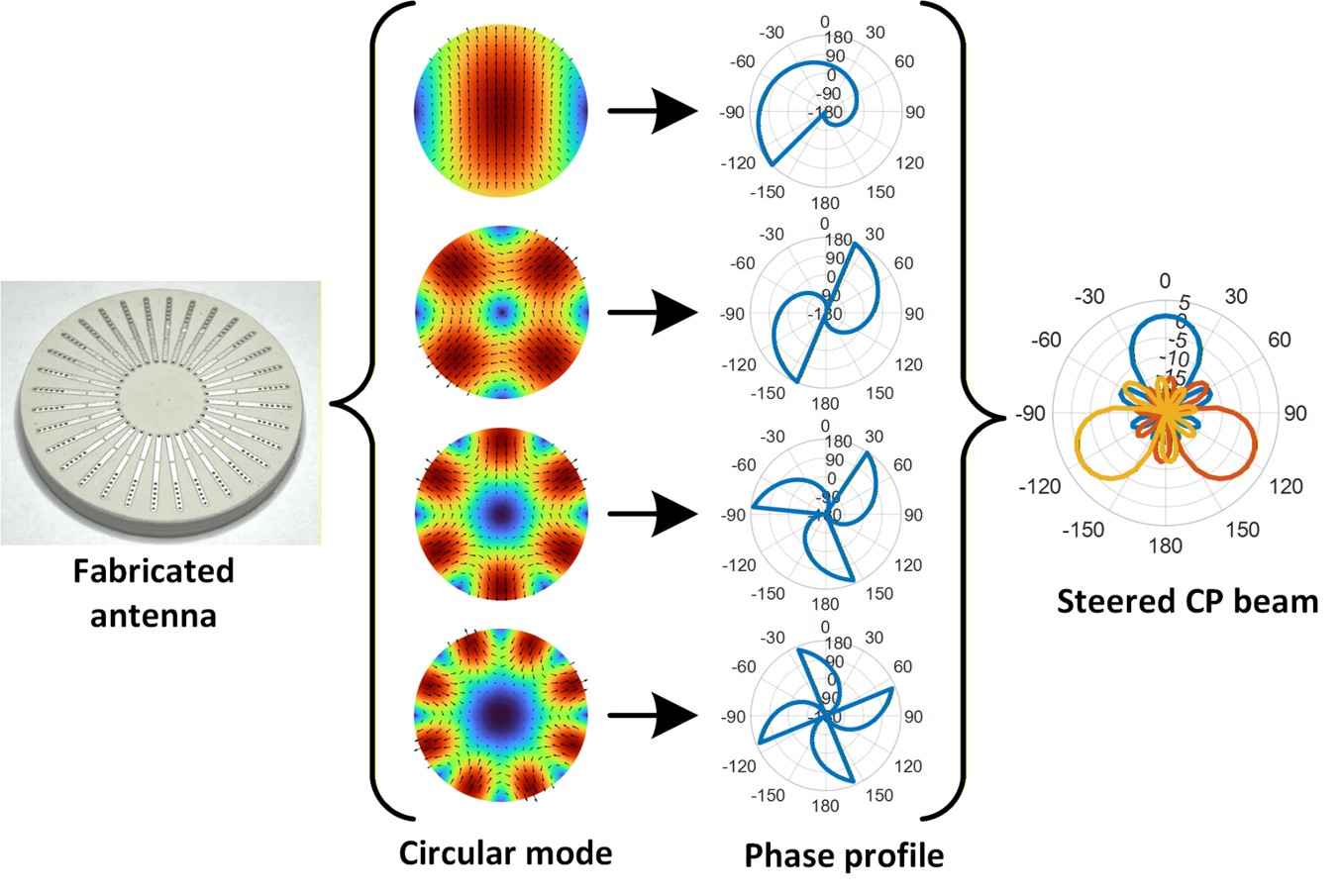
Beamforming and steering, which have been typically achieved using phased array antennas, allow for mitigating the propagation loss of energy and are essential in modern communication and radar systems. This work introduces an innovative technique based on superimposing circular waveguide TEn1 modes for circular polarized beamforming and 360° beam steering. A remarkable advantage of this method is its realization using a single relatively compact antenna structure. This beamforming/steering antenna has potential applications in user mobile devices, base stations, repeaters, and radars. Moreover, owing to its circular polarized radiation, it offers improved immunity to issues like multipath fading and multiple reflections and eliminates the need for precise alignment of the Tx and Rx antennas.
-
low-power low-temperature-coefficient oscillators
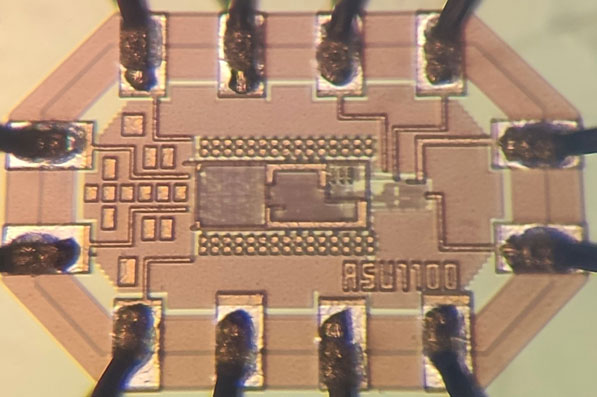
The growth of demand for autonomous vehicles and higher data rates in communication protocols and hardware interfaces like CAN bus and USB has raised the need for stable clock sources that maintain a low temperature coefficient (TC) over a wide temperature range (e.g. from -20°C to +100°C). Additionally, a robust oscillator consuming a very low amount of power is also crucial in wearables, network sensors, and IoT. Traditionally, temperature-dependent frequency variation has been mitigated using off-chip components, but this approach comes at the cost of increased size and power consumption. We have presented a generalized PTAT-controlled temperature compensation methodology for supply-independent low-power CMOS ring oscillators.
-
Integrated harmonic rejection mixers

With advances in technology and the growing demand for wireless communications, the need for wider bandwidth in telecommunication systems is steadily increasing. Broadband systems are highly valued for their ability to support high data rates and aggregate multiple frequency bands, thereby enhancing network capacity. A key challenge in broadband systems is nonlinearity, which becomes more critical as bandwidth increases. Factors such as harmonic distortion and intermodulation, caused by local oscillator switching signals and system nonlinearities, can distort signals and degrade overall system performance. Harmonic rejection mixers (HRMs) can significantly reduce harmonics especially the third and fifth and mitigate their adverse effects without relying on bulky, power-hungry filters. This is particularly important for applications such as software-defined radios, cognitive radio systems, and next-generation wireless networks, where maintaining signal integrity is crucial. We have presented a novel HRM architecture that effectively suppresses unwanted harmonics while achieving high linearity, improved conversion gain, and reduced power consumption.
-
Spectrally-Adaptable Spread-Time CDMA Low-IF Transceiver

Spread-time CDMA (ST-CDMA) is the time–frequency dual of conventional spread-spectrum CDMA, in which the signal is coded in the frequency domain. This enables flexible spectral shaping and adaptation to channel and interference conditions, making it well suited for narrowband IoT applications. Based on the properties of ST-CDMA, we are developing a fully integrated system-on-chip (SoC) that combines the analog front end and the digital baseband. The digital functions will be implemented in a dedicated application-specific integrated circuit (ASIC). Such a fully integrated solution supports on-chip calibration and substantially reduces receiver power consumption. Furthermore, integrating the entire ST-CDMA transceiver both encoder and decoder within a single SoC enables scalable multi-node IoT deployments with improved energy efficiency and cost-effectiveness, which are critical for battery-powered IoT systems.
-
self-calibrating phased arrays
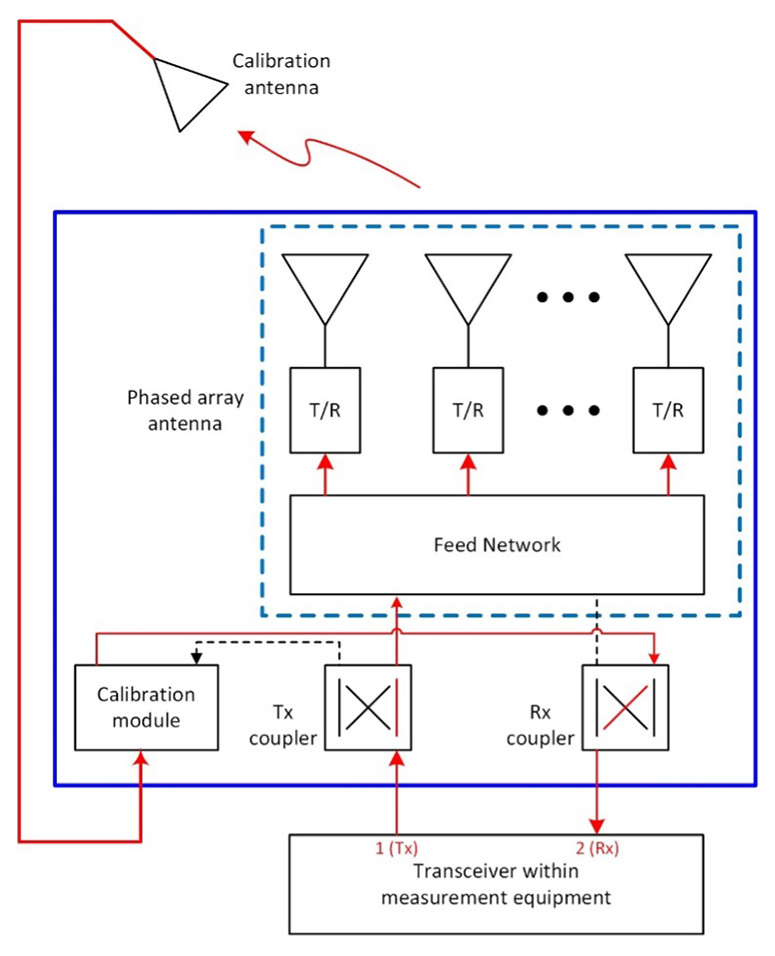
Self-calibrating phased arrays are capable of autonomously calibrating and optimizing their performance without external calibration equipment or any manual adjustment. These arrays include multiple antenna elements that can dynamically adjust their excitation phase and amplitude settings to compensate for component variations, environmental changes, or other sources of interference. Integrated self-calibrating phased arrays offer significant advantages, but they also face several challenges, including high power consumption, large area, complex circuitry, and limited tuning range. In this project, we focus on developing a low-complexity, compact, and low-power self-calibrating phased array with a large tuning range to facilitate their commercial use.
